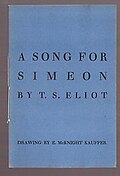Wikipedia:Today's featured article/requests/A Song for Simeon
A Song for Simeon[edit]
This nomination predates the introduction in April 2014 of article-specific subpages for nominations and has been created from the edit history of Wikipedia:Today's featured article/requests.
- This is the archived discussion of the TFAR nomination for the article below. Subsequent comments should be made on the appropriate discussion page (such as Wikipedia talk:Today's featured article/requests). Please do not modify this page.
The result was: scheduled for Wikipedia:Today's featured article/February 3, 2014 by BencherliteTalk 19:01, 26 January 2014 (UTC)
"A Song for Simeon" is a 37-line poem written in 1928 by American-British poet T. S. Eliot (1888–1965). It is one of five poems that he contributed to the Ariel poems series of 38 illustrated pamphlets with holiday themes by several authors published by Faber and Gwyer and sent to the firm's clients and business acquaintances as Christmas greetings. Eliot had converted to Anglo-Catholicism in 1927 and his poetry, starting with the Ariel Poems (1927–31) and Ash Wednesday (1930), took on a decidedly religious character. The poem retells the story of Simeon from the Gospel of Luke. Simeon was a devout Jew told by the Holy Ghost that he would not die until he saw the Saviour of Israel. When he encounters Mary, Joseph and the infant Jesus entering the Temple of Jerusalem, he sees in the infant the Messiah promised by the Lord and asks God to permit him to "depart in peace." Eliot's poem employs references to the Nunc dimittis, a Christian liturgical prayer for Compline, and literary allusions to earlier writers Lancelot Andrewes, Dante Alighieri and St. John of the Cross. Several critics have debated whether Eliot's depiction of Simeon is evidence of Eliot's anti-Semitism. (Full article...)
- Promoted to FA this morning, awaiting the star.[1] Didn't assess points. COUNT: 203 words, 1,211 characters (with spaces). Not really interested in a relevant date, but since Simeon is connected with the liturgical feast of the presentation (i.e. Candlemas), either 2 February (western Christianity) or 15 February (Orthodox) could be considered relevant. I see 2 February is already scheduled, but the date doesn't matter to me.--ColonelHenry (talk) 16:33, 23 January 2014 (UTC)
- Charlie Chaplin got there first for 2nd Feb, but how about 3rd Feb, listed as Simeon (Gospel of Luke) as one of his feast days? The article there has no date link and could be bumped back to later in Feb. BencherliteTalk 16:42, 23 January 2014 (UTC)
- The 3rd would work well (which the church chose assuming that God let him die as promised after seeing the Messiah the day before). Date doesn't matter as much to me, so I defer to your judgment.--ColonelHenry (talk) 16:49, 23 January 2014 (UTC)
- Charlie Chaplin got there first for 2nd Feb, but how about 3rd Feb, listed as Simeon (Gospel of Luke) as one of his feast days? The article there has no date link and could be bumped back to later in Feb. BencherliteTalk 16:42, 23 January 2014 (UTC)
- Support. Nice high quality educational article. — Cirt (talk) 00:16, 26 January 2014 (UTC)

